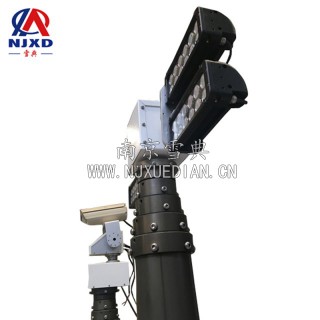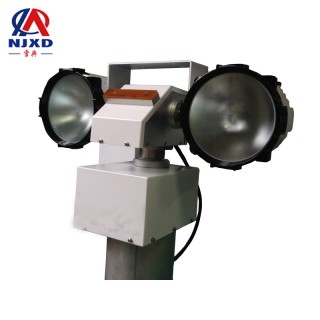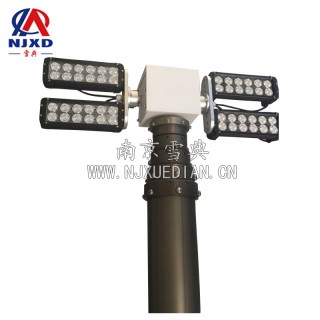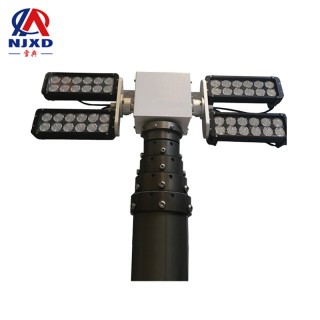NEWS
Performance Index of lifting head
Time:2021-02-04 View:

Rotational velocity
The rotational velocity of the PTZ is an important indicator to measure the level of the PTZ. The horizontal and vertical directions of the pan-tilt are driven by two different motors, so the rotational velocity of the pan-tilt is also divided into horizontal rotation speed and vertical rotation speed. Due to the load, the torque of the vertical motor during start-up and running maintenance is greater than that in the horizontal direction, and the requirement for horizontal rotation speed during actual monitoring is higher than that of the vertical rotation speed, therefore, generally speaking, the vertical rotation speed of the pan-tilt is lower than the horizontal rotation speed.
The AC PTZ is fixed with AC motor rotational velocity, generally, the horizontal rotational velocity is 4 °/second ~ 6 °/second, and the vertical rotational velocity is 3 °/second ~ 6 °/second. Some manufacturers also produce AC high-speed PTZ, which can reach horizontal 15 °/second and vertical 9 °/second, but the high-speed load capacity of the same series PTZ will be reduced accordingly.
Most of the DC pan-tilt units use DC stepping motors, which have the advantages of high rotating speed and variable speed, and are very suitable for occasions requiring fast target capture. Its horizontal highest revolving speed can reach 40~50 °/second, and vertical can reach 10~24 °/second. In addition, the DC head has the variable speed function, and the voltage provided is the variable voltage between 0 and 36V DC. The effect of variable speed is determined by the performance of the control system and decoder, so that cloud deck motor can rotate at the corresponding speed according to the input voltage. There are two common variable speed control methods. One is full variable speed control, which determines the input voltage to the pan head by detecting the displacement of the operator to control the keyboard joystick, full speed control is to realize smooth speed transition within the speed range of PTZ. The other is the step-by-step control, which is to set several gears within the speed range of the PTZ. Each gear corresponds to different voltage (rotational velocity). Before operation, you must first select the speed gear to be rotated, rotate the head in all directions.

Rotation angle
The rotation angle of the pan-tilt, especially the vertical rotation angle, has a great relationship with the installation method of the load (shield/Camera/lens assembly). Generally, the horizontal rotation angle of the pan-tilt can reach 355 °, because the limit Bolt will occupy a certain angle, but there will be a little monitoring dead angle. The current PTZ has improved the limiting device so that it can reach 360 ° or even 365 ° (with a coverage angle of 5 °) to eliminate the monitoring dead angle. Users can set the limit according to the actual situation on site when using it. For example, the Wall Mounted type installed on the wall, even if the PTZ has a 360 ° rotation angle, actually only needs to monitor the 180 ° angle on the front of the PTZ, even if it turns to 180 ° in the rear direction, it can only see the installation surface (Wall), which has no practical monitoring significance. Therefore, the wall-mounted type only needs to monitor the range of 180 ° and the angle-mounted type only needs to monitor the range of 270 °. This prevents the pan-tilt from rotating too much to a position without monitoring, and also provides the use efficiency of the pan-tilt.
The vertical rotation angle of the top-mounted head is generally +30 ° to-90 °, and the vertical rotation angle of the side-mounted head can reach ± 180 °, however, the vertical rotation angle can be from +20 ° to-90 ° during normal use.
Load capacity
The maximum load of the pan-tilt is the maximum load capacity in the vertical direction. The distance between the center of gravity of the camera (including the shield) and the working face of the PTZ is 50mm. The center of gravity must pass through the center of rotation of the PTZ and be perpendicular to the working face of the PTZ. This center is the maximum load point of the PTZ, the bearing capacity of the pan-tilt is based on this point. If the load position is not properly installed, the center of gravity deviates from the center of rotation, increasing the load torque, the actual load capacity will be less than the design value of the maximum load. Therefore, the greater the vertical rotation angle of the pan-tilt, the greater the deviation of the center of gravity, and the smaller the corresponding bearing weight.
The load capacity of the PTZ is the key to select the PTZ. If the load capacity of the PTZ is less than the actual load, the operation function will not only decrease, but also the motor and gear of the PTZ will be damaged due to long-term overload. The actual load capacity of the pan-tilt can vary from 3kg to 50kg. For the same series of pan-tilt products, the bearing capacity during side loading is greater than that of the top mounting, and the bearing capacity of the high-speed type is smaller than that of the ordinary type.

Environmental indicators
The requirements of indoor PTZ are not high, and the indicators of the usage environment of PTZ are mainly aimed at outdoor PTZ. This includes the IP protection level of environment temperature limit, humidity limit and dustproof and waterproof. Generally, the PTZ temperature range used in outdoor environment is-20 ℃ to +60 ℃. If it is used in lower temperature environment, A temperature-controlled heater can be installed inside the pan-tilt to make the lower temperature reach-40℃ or lower. The humidity index is generally 95% non-condensing. The IP level of dustproof and waterproof shall be above ip66. The level of IP protection reflects the sealing degree of equipment, which mainly refers to dust prevention and liquid intrusion. It is an international standard and conforms to the BS5490 standard in 1997 and the IECS529 standard in 1976. The first value after IP indicates the degree of solid seal protection, the second position indicates the degree of liquid protection, and the third position indicates the degree of mechanical impact protection. In addition, in actual use, appropriate materials and protective layers should be selected according to the environment. For example, iron shell is not suitable for use in humid and corrosive environments.
First and Second
0 unprotected
1 Solid matter up to 50mm, such as the vertical drop of accidental contact with water by hand, such as condensation
2 Solid matter up to 12mm, such as direct spraying of finger water, tilt no more than 15 °
3 Solid matter exceeding 2.5mm, such as spraying of tools, wires and water, the inclination shall not exceed 60 °
4 solid matter more than 1mm, such as tools, fine wire water spraying from all directions, allowing limited invasion
5 dustproof-limited intrusion (ensuring no damage to the equipment) water is injected at low pressure from all directions, allowing limited intrusion
6 safe and dustproof water is sprayed in high pressure from all directions, such as cabins, allowing limited intrusion
7 immersed in underwater 15cm to 1m
8 immersed underwater for a long time
Return difference
Return difference, also known as Gear clearance (Gear Backlash), is an important indicator to investigate the rotation accuracy of the pan-tilt.
Reliability
The reliability of the pan-tilt is generally measured by the average failure (interval) time MTBF, the average repair time MTTR, the average failure-free time MTTF, and the limit times of the dynamic switch.
